iPad 4 (Late 2012) Review
by Anand Lal Shimpi on December 6, 2012 4:40 PM ESTCPU Performance
Like the A6, the 4th generation iPad's A6X integrates two custom designed Apple Swift CPU cores that implement the ARMv7 instruction set. The two cores share a 1MB L2 cache, just like they do in the iPhone 5's A6. I spent a lot of time characterizing the architecture and performance of Swift in our iPhone 5 review, so I won't go over a lot of that here. What I will say is that Swift manages to be the best balance of performance and power efficiency in an ARM based CPU core available today. Swift looks a lot like Apple's take on Qualcomm's Krait core. It's not a Cortex A15 competitor from a performance standpoint, but likely a more power efficient design.
Unlike what we saw in the previous iPads, the A6X only boasts a marginal increase in max clock speed (~7%) over the A6. The two Swift cores can run at up to 1.4GHz in the A6X compared to 1.3GHz in the A6.
| Apple iPhone/iPad CPU Clock Comparison | |||||
| iPhone | iPad | iPad Frequency Advantage | |||
| Apple A4 Generation | 800MHz | 1.0GHz | 25% | ||
| Apple A5 Generation | 800MHz | 1.0GHz | 25% | ||
| Apple A6 Generation | 1.3GHz | 1.4GHz | 7.7% | ||
CPU performance improves substantially over the 3rd generation iPad thanks to the Swift cores. Unfortunately, big gains in CPU performance aren't always apparent in actual use. The iPhone 5 seemed to subjectively gain more from the move to A6, partially because of just how frequency constrained the A5 in the 4S was. The A5X CPUs in the iPad 3 were already running 25% faster than the A5's CPU cores.
I didn't notice appreciable differences in application launch times, but there are a few areas were the faster CPU cores definitely stand out. Auto enhance in iPhoto completes quicker on the iPad 4 vs. its predecessor. This is especially true for work on large (high MP) images. I don't think a pair of Swift cores is all it takes to make the iPad 4 a suitable photo retouching workstation but it's better than the previous model.
| General Use CPU Performance Comparison | |||||
| iPad 2/mini | iPad 3 | iPad 4 | |||
| iPhoto Auto Enhance 36MP JPG | 11.7 seconds | 12.0 seconds | 9.1 seconds | ||
| Batman: The Dark Knight Rises Level Load Time | 36.3 seconds | 35.9 seconds | 31.1 seconds | ||
Scrolling around iOS Maps in 3D view is substantially smoother on the 4th gen iPad compared to its predecessor. We noticed something similar in our comparison of the iPhone 5 and 4S. Web pages do load quicker on the iPad 4, although the differences can be small depending on the complexity of the page in question. The real world responsiveness benefit from the faster CPU cores seems to be in the 10 - 30% range depending on what you're doing. The problem is at the lower end of the scale, it can be difficult to really feel if you're comparing the 3rd and 4th gen iPads.
We're still very limited in good, cross-platform CPU benchmarks. We, once again, turn to JavaScript tests run in the browser. For all of the tablets tested here we're using Chrome for Android and Mobile Safari for iOS.
SunSpider has been a part of all of our mobile performance testing for quite a while now. It's not the perfect benchmark, but the test ends up being a good measure of browser performance as well as cache latency and CPU performance.
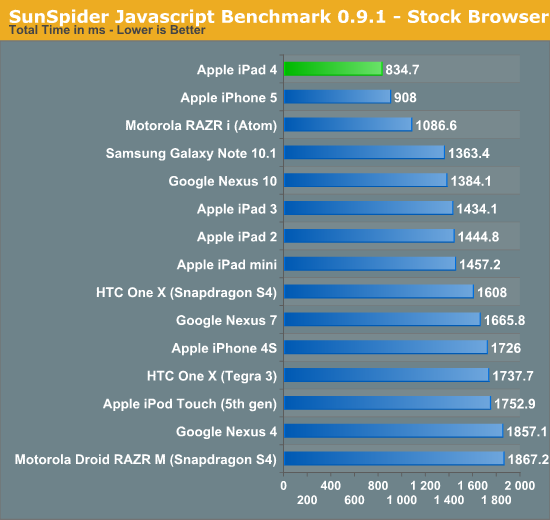
The Swift cores do an excellent job here thanks to their much improved memory performance. The Nexus 10 should be competitive however the current state of browser optimizations hold it back a bit here.
Google's Octane benchmark is a much larger test than SunSpider, but we're still looking at JavaScript performance. Octane includes all 8 of the tests from Google's older V8 benchmark but adds 5 new ones including a PDF reader, 3D bullet physics engine and portable 3D game console emulator all built in javascript.
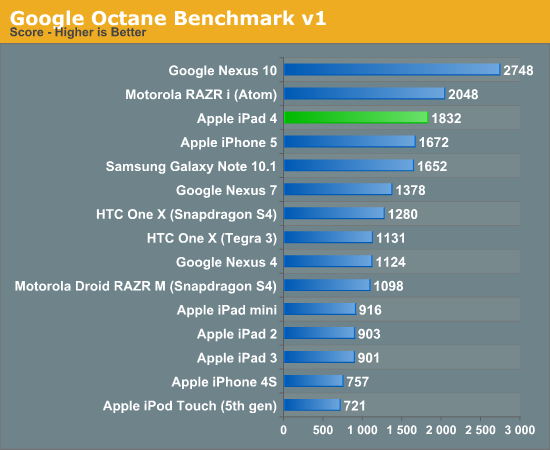
Octane tells a very different story. The iPad 4 does very well, but the Nexus 10's Cortex A15s are really allowed to shine here. The A15 is simply in a different league of performance.
Finally we have Kraken, a seriously heavy javascript benchmark built by Mozilla. Kraken focuses on forward looking applications that are potentially too slow to run in modern browsers today. The result is much longer run times than anything we've seen thus far, and a very CPU heavy benchmark:
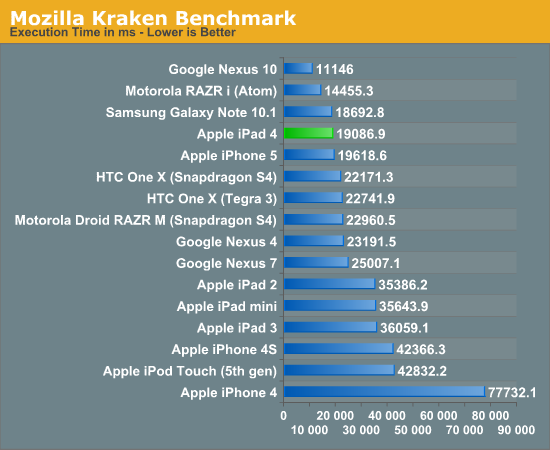
We see a similar story with Kraken. Apple improved CPU performance tremendously over the iPad 3, but the Nexus 10 is able to reach new heights.
Why don't we see a direct correlation between these CPU bound js tests and the real world performance numbers I mentioned above? The problem is that most of today's iOS apps are really built for the sort of performance that a pair of Cortex A9s can deliver. I see pockets of CPU bound activity but it's not consistent enough where you're going to necessarily see a dramatic improvement in responsiveness across the board. I do believe the gap is more apparent on the iPhone thanks to the huge difference in frequency between the 4S and 5, but on the iPad the range from subtle to noticeable differences is broader.
Memory Bandwidth
A look at Chipworks' die shot reveals the same memory interface arrangement as we saw in the A5X:
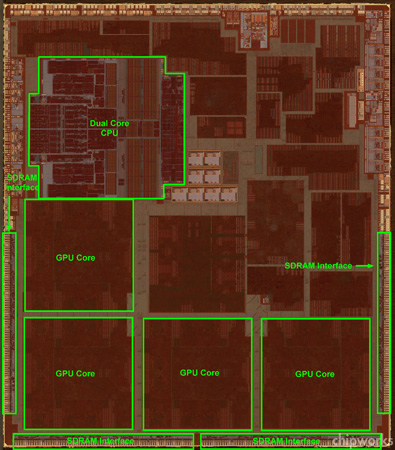
Apple A6X die via Chipworks
The A5X/A6X place the memory interface blocks (and perhaps the controllers themselves?) adjacent to the GPU, while the A5/A6 more tightly integrate the CPU and memory controller. This highlights a pretty substantial difference in priority between the A5/A6 and A5X/A6X SoCs. The latter really do prioritize memory bandwidth delivery to the GPU, and for good reason. The Retina Display equipped iPads have over 4x the number of pixels as the iPhone 5.
The 4th generation iPad that iFixit took apart had 1GB of Hynix LPDDR2-1066 on-board, which would indicate a small increase in memory bandwidth. Just as we saw with the A5/A5X comparison, the additional memory bandwidth doesn't appear to be available to the CPU cores - only the GPU cores.


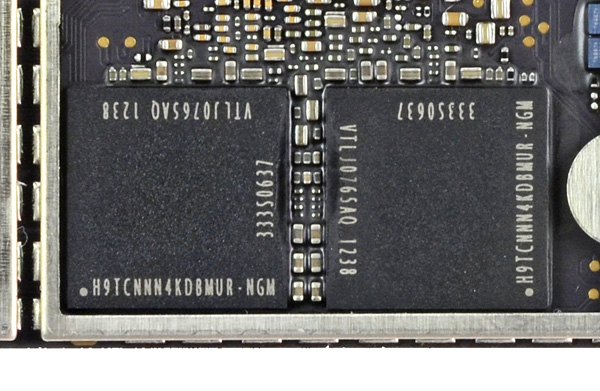
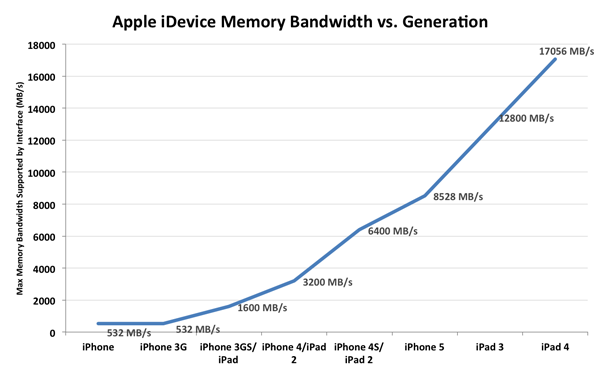








113 Comments
View All Comments
cheinonen - Thursday, December 6, 2012 - link
Color quality has always been a target, just not one that was possible for us to easily measure before. Now that we can, it's in almost every review. If that seems to favor Apple, that's only because other vendors refuse to care about it, and they aren't going to start caring until consumers understand and demand better.ltcommanderdata - Thursday, December 6, 2012 - link
It's not that pixel density is no longer important. It's that Apple has already satisfied people's needs for high pixel density. Most people already won't notice individual pixels on the iPad's 264 dpi display. So either Apple continues to improve pixel density for very little actual benefit, stops improving displays altogether, or they find another aspect of displays to improve. I think most people will be happy Apple choose the latter option and are improving color gamut and calibration.bplewis24 - Thursday, December 6, 2012 - link
I'm glad somebody else notices this. Taking a page straight out of Apple's Marketing dept.teiglin - Thursday, December 6, 2012 - link
Does Apple actually market their products this way? It's not like he's harping on it, but the S.S. Pixel Density set sail a year ago and all the high-end tablets are sufficient for most people (even the TF700, in my opinion--the steps from that to the iPad 4, then to the Nexus 10, are fairly incremental). Apple continues to differentiate its displays with proper calibration, and Anand is just pointing that out. As displays get better, it requires more attention to find the differences.The color accuracy on the Nexus 10 is objectively bad. I say this as someone who wants Google to step it up in this area--I have a Samsung tablet and my primary phone is HTC and have never owned an iPad or a Mac. Superior color accuracy isn't going to make me buy an iPad, but a dE over 8 on the Nexus 10 does make me think it's worth waiting for the generation of Google tablet.
bplewis24 - Thursday, December 6, 2012 - link
Check out their marketing materials and yes, even some of their commercials. When the coined the term "retina display" they immediately began publishing PPI measurements (and comparisons) in their marketing materials. The reason why this is significant is because other displays eventually caught up and surpassed in sheer resolution, but because the iPhone was smaller, the PPI measurement still stayed on top...even though, ironically, the benefits of such a high PPI and a much smaller display are harder to benefit from.cheinonen - Thursday, December 6, 2012 - link
The value of PPI has nothing to do with screen size, but distance relative to PPI. Just like an 84" 4K LCD has benefits if you sit 5' from it but no benefit if you are 25' from it compared to a same size 1080p display. The half-inch viewfinder of the camera I just bought has a 2.4 million dot OLED display. If that used the same PPI as a retina iPhone, with 3 dots per pixel, then that viewfinder would only have 0.2 million pixels and would certainly not be as sharp.However, as my eye is literally right next to that, a resolution way beyond 300 PPI is useful, despite the incredibly small size of the display. It's all about the distance relative to the PPI, not the size of the screen.
teiglin - Thursday, December 6, 2012 - link
I wasn't asking if they market PPI; I know that's the theme of the whole "retina" marketing. I was asking if they market the color accuracy and how their calibration is better than the competitors'. I've seem them mention the iPad's gamut (albeit briefly) but never its accuracy or calibration.EnzoFX - Thursday, December 6, 2012 - link
That's called avancement. The basis of technological progress. There Should always be something better to pursue. That is good for everyone. No matter how much your bias against Apple is.cheinonen - Thursday, December 6, 2012 - link
One more note on this. CalMAN 5 is used for measuring smartphones and tablets (and likely monitors in the future) since it supports measuring grayscale, gamut, saturations, and Gretag Macbeth charts, at any targets that we want, and with manual patterns instead of only internal pattern generators. Most solutions only allow for internal generators, which is why previous tablet and smartphone reviews (many of which were done well before Apple made a deal out of this) lack these charts as those programs don't run on an iOS or Android device.CalMAN 5 wasn't even released until September of this year, making most of these measurements impossible to do before then. So you can enjoy the conspiracy theories, but had these measurements been possible for me to do 18 months ago, I'd have done them 18 months ago.
JarredWalton - Friday, December 7, 2012 - link
On a related note, we've been discussing the importance of color accuracy on our LCD and laptop reviews for... oh, let's see... May of 2007.http://www.anandtech.com/show/2237
You'll notice that of all the laptop manufacturers, only Apple is consistently getting the display quality right (or at least, more right than others) for the MacBook Pro. And even that took a few years after my rant.